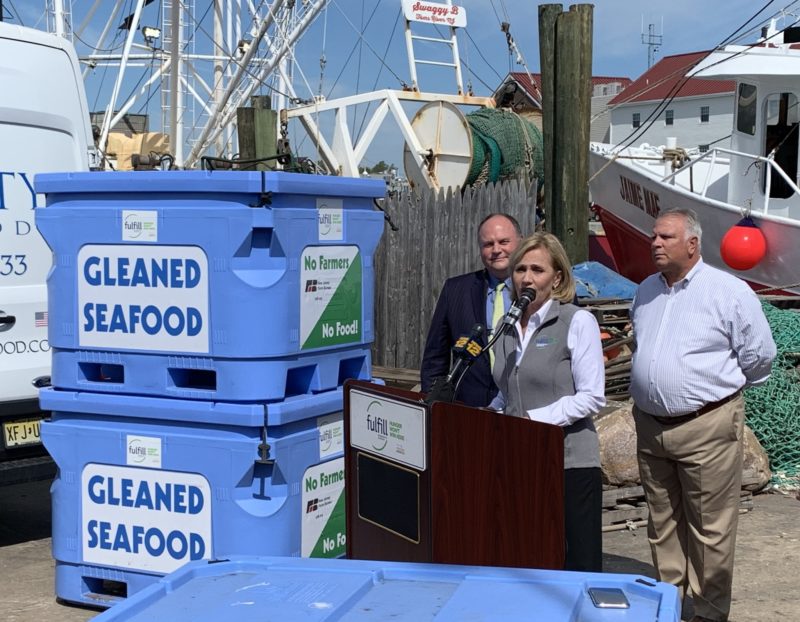A pilot project to give commercial fishing bycatch to the hungry officially launched Friday in New Jersey, where the America’s Gleaned Seafood volunteer program and Trinity Seafoods have made the first deliveries.
“They have a lot of leftover fish they can’t use. But its’s perfectly good fish,” said Kim Guadagno, the CEO and president of Fulfill, a nonprofit regional food bank, at a media conference at the Fishermen’s Dock Cooperative in Point Pleasant Beach, N.J.
After more than two years of careful organizing, gleaning advocates made the first deliveries in August, moving 2,300 pounds of unregulated species — mostly cownose and bat rays — that were processed and frozen into 630 pounds of kitchen-ready product at Trinity’s facility in Lakewood, N.J., said company president Mike Carson.
The fish went to several pantries, soup kitchens and a women’s shelter. St. Mark’s Food Pantry and Soup Kitchen in Keansburg, N.J. was one of the first users, where its chef used ray as the basis for cioppino, an Italian-style fish stew.

The crew of the Arianna Maria, one of the Fishermen's Dock Cooperative boats participating in America's Gleaned Seafood, packs out at the co-op dock. Fulfill photo
The fish were well-received by users, and will help fill a chronic shortage for food banks, said Guadagno, a former New Jersey lieutenant governor.
Fulfill serves Monmouth and Ocean counties on the New Jersey coast, where “136,000 people will go to bed tonight not knowing where they’re next meal is coming from. Fifty thousand of them are children,” she said. “I can’t keep enough protein on the shelf. This fish is a found source of protein.”
Nutritionally the fish fills another gap for chronically underfed families.
“It’s the omega-3 fatty acids that feed your brain… they’re essential for children’s brain developer,” said Erin Leo, a Fulfill dietician and program coordinator. Having locally delivered fish in the food bank system benefits adults in the same way, and is particularly helpful for older adults at risk of neurological deteriorating and vision problems, she said.
“We’re gleaning non-regulated species,” and fishermen cannot earn any money or get a tax write-off for their contributions, Wenzel stressed.
“Fishermen want to do this. One of the worst things is having to throw fish overboard,” he said. The initial effort is backed by a $50,000 grant from the Tyson Foods Protein Innovation Fund, and support from Trinity’s corporate parent Sysco Foods.

Martin McHugh, executive director of America's Gleaned Seafood, and NMFS special agent Jed Fiske check out a container of iced cownose rays destined for the Fulfill food bank. America's Seafood Gleaning photo
America’s Gleaned Seafood executive director Martin McHugh used to head the New Jersey Division of Fish and Wildlife. Finding a better way to handle bycatch has long been on his mind.
“I wanted to do this when I was (state) director, because we had Hunters Helping the Hungry,” a volunteer effort that delivered venison to the needy, McHugh said.
Of course, given the high level of management and regulation on commercial seafood harvest, it has taken a lot of work by Wenzel and McHugh to get a system that all the participants — fishermen, law enforcement, docks, processors and non-profit groups — could buy into.
“It’s an ecosystem of people you need to make this work,” McHugh said. The New Jersey state departments of agriculture, environmental protection and his old colleagues at Fish and Wildlife have been especially supportive, he said.
State and NMFS law enforcement agents work with the program, observing bycatch pack out into designated containers with tickets for delivery to Trinity. An early test run used 1,000 pounds of scup that were landed at a time of zero market demand and could be used to test the delivery system and processing, McHugh said.
Boats working for the program out of the co-op include the draggers Arianna Maria, Kailey Ann, and Amber Waves. Organizers were anticipating squid and sea robins to be in the next round going out to Trinity.
Joseph Leone Introna, a Point Pleasant Beach chef and caterer who serves on Fufill's board of trustees, helps develop recipes to go along with the Gleaned Seafood products.
"From a chef's point of view, protein is protein," said Introna. "It's all about flavor development. It's all about developing the taste and the mouth feel."

Chef Ray Cattley prepares ray wing in Fulfill's kitchen in Neptune, N.J. Fulfill photo
For some fish, an addition of breading helps develop that taste. Traditional cuisines are another source of ideas. One Fulfill recipe for "Chesapeake ray Provencal" is a take on skate wings as cooked in the south of France.
"My family comes from Italy. We have a species that's very similar to skate," said Introna. "We make soup with it, baked wings."
Trinity’s Lakewood plant is an easy drive from New Jersey’s four main fishing ports and Guadagno and Wenzel are confident the program can grow. The organizers have aspirations of helping it go national to other U.S. fishing communities.
“If we can get 1 percent of the fishermen in the continental United States to participate in the Seafood Gleaning Program, we could serve 420 million meals a year to the nation’s food insecure,” said Wenzel.
Ultimately, the goal should be to get beneficial bycatch use made part of every fishery management plan, he said.
“We’re anticipating 30, 40, 50 years to get this fully running,” considering the decade-long cycles that the regional fishery management councils and interstate commissions work on, Wenzel said, “to get this into every fishery management plan.”







